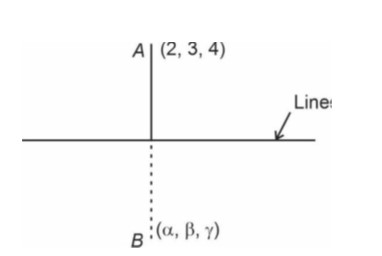Let a plane P contain two lines r = î + λ(î + ĵ), λ ∈ R and r = −ĵ + μ(ĵ − k̂), μ ∈ R. If Q(α, β, γ) is the foot of the perpendicular drawn from the point M(1,0,1) to P, then 3(α + β + γ) equals
Let a plane P contain two lines r = î + λ(î + ĵ), λ ∈ R and r = −ĵ + μ(ĵ − k̂), μ ∈ R. If Q(α, β, γ) is the foot of the perpendicular drawn from the point M(1,0,1) to P, then 3(α + β + γ) equals
-
1 Answer
-
Normal of plane = |î? k|
|1 0|
|0 1 -1|
n = -î+? +k
D.R.'s = -1,1,1
Plane => -1 (x-1)+1 (y-0)+1 (z-0) = 0
=> x-y-z-1=0
If (x, y, z) is foot of perpendicular of M (1,0,1) on the plane then
(x-1)/-1 = (y-0)/1 = (z-1)/1 = - (1-0-1-1)/3
x=4/3, y=-1/3, z=2/3
α+β+γ = 4/3 - 1/3 + 2/3 = 5/3
Similar Questions for you
....(1)
Let
Let
Put l1 and l2 in (1)
α = 3
Given , ,
Dot product with on both sides
... (1)
Dot product with on both sides
... (2)
(a – 1) × 2 + (b – 2) × 5 + (g – 3) × 1 = 0
2a + 5b + g – 15 = 0
Also, P lie on line
a + 1 = 2λ
b – 2 = 5λ
g – 4 = λ
2 (2λ – 1) + 5 (5λ + 2) + λ + 4 – 15 = 0
4λ + 25λ + λ – 2 + 10 + 4 – 15 = 0
30λ – 3 = 0
a + b + g = (2λ – 1) + (5λ + 2) + (λ + 4)

Take
x = 2λ + 1, y = 3λ + 2, z = 4λ + 3
= (α − 2)
Now,
(α − 2) ⋅ 2 + (β − 3) ⋅3 + (γ − 4) ⋅ 4 = 0
2α − 4 + 3β − 9 + 4γ −16 = 0
⇒ 2α + 3β + 4γ = 29
Taking an Exam? Selecting a College?
Get authentic answers from experts, students and alumni that you won't find anywhere else
Sign Up on ShikshaOn Shiksha, get access to
- 65k Colleges
- 1.2k Exams
- 679k Reviews
- 1800k Answers
